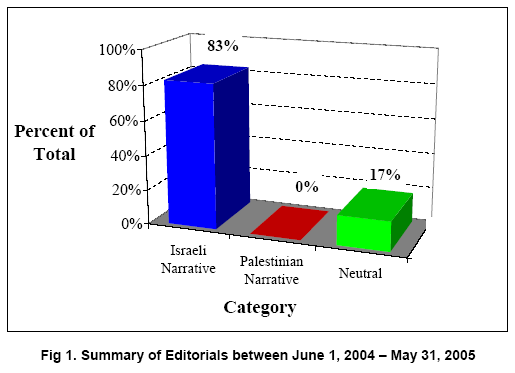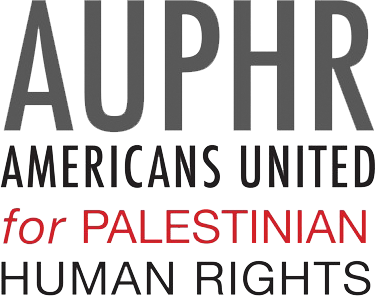Oregonian Exclusions Covering the Palestine / Israel conflict
"on probably the most enduring and insistent foreign policy issue of our time, we routinely do not hear from one side" -- Don Wycliff, Chicago Tribune
See also: AUPHR's report on the Oregonian's news coverage
Download the full editorial report here: www.auphr.org/docs/OregonianEditorialReport.pdf

I. Executive Summary
As the only daily newspaper in the State of Oregon with state-wide circulation and the largest newspaper in the Pacific Northwest, the Opinion Page editors of The Oregonian carry the burden of a public trust to provide a wide-open forum for debate on the pressing issues of our day. With respect to the debate on the Israeli- Palestinian conflict, however, the editors of the Opinion Pages have failed to meet their obligations to the public. This report documents the findings of a one-year study of the Opinion Pages of The Oregonian conducted by Americans United for Palestinian Human Rights and Palestine Media Watch. Specifically, this report is concerned with the content presented in The Oregonian's Editorial Section and the newspaper's selection of commentaries, cartoons, and letters to the editor dealing with the Israeli-Palestinian conflict for the period beginning on June 1, 2004 and ending on May 31, 2005.
The quantitative part of this study was performed using the Content Analysis methodology. The method was used to select and classify the editorials, op-eds, letters, and cartoons that were related to the Israeli-Palestinian conflict into three classes or narratives. The three general narratives under which each item was classified were the Israeli-narrative, Palestinian-narrative and the Neutral-narrative. Also presented is a qualitative assessment in the form of two in-depth case studies for the months of June and July of 2005.
Among the study's key findings are the following:
- 83 percent of all published editorials on this issue reflected an Israeli-narrative with 0 percent of editorials reflecting the Palestinian-narrative.
- With respect to commentaries or op-eds, 56 percent promoted the Israeli- narrative while only 4 percent exhibited attributes of a Palestinian-narrative.
- The majority of cartoons, 62 percent, represented attributes of an Israeli- narrative, while 38 percent exhibited attributes of a Palestinian-narrative.
- Most editorial space and selected commentaries dealing with the Israeli- Palestinian conflict largely present the Israeli-narrative and rarely debate the illegal and immoral nature of Israel's actions.
- The Oregonian has seriously constrained the nature and range of voices available to readers on the Israeli-Palestinian conflict. There is also a noted failure to respond or react to news items indicating Israel's gross violation of Palestinian human rights and its noncompliance with international law.
- The Cartoon Section was tilted to the Israeli-narrative and complimented the content of the Editorial and Commentary sections of The Oregonian in reinforcing this view. The Letters to the Editor Section, though more representative of a Palestinian-narrative, is, by its nature, an insufficient counterbalance to the Israeli-narrative presented regularly in the other sections of The Oregonian's Opinion Pages.
Over an extended period of time, one would have expected to find balance in the treatment of the Israeli-Palestinian conflict in the Opinion Pages of The Oregonian. Like the news sections of the newspaper, the material presented in the Opinion Pages should also meet basic journalistic standards of balance, fairness and accuracy. Rather than make the newspaper a forum where the Israeli-Palestinian conflict might be debated and discussed, however, little in the Opinion Pages has deviated from the official Israeli government positions. This is reflected in what is or is not discussed, the timing of the issues presented in the editorials and commentaries, and how those issues are framed.
The results of this one-year study demonstrate that the hypothesis that The Oregonian Opinion Pages provide a wide-open forum for debate is false. In fact, the editorial and commentary sections of The Oregonian very seldom provided an opportunity for readers to be exposed to a Palestinian-narrative of the Israeli- Palestinian conflict or to a neutral human-rights centered perspective.
The Oregonian has largely excluded voices coming from the Palestinian-narrative from the discussion of current events on this conflict. Discussion of international human rights, humanitarian law and violations of the same were also largely left out. The result is that the newspaper has narrowly defined the arguments that are allowed to participate in this debate. The systematic over-representation of the Israeli-narrative and significant silence about important issues, such as international laws and humanitarian norms, raises serious questions about The Oregonian's commitment to journalistic standards for balance, fairness and accuracy.
